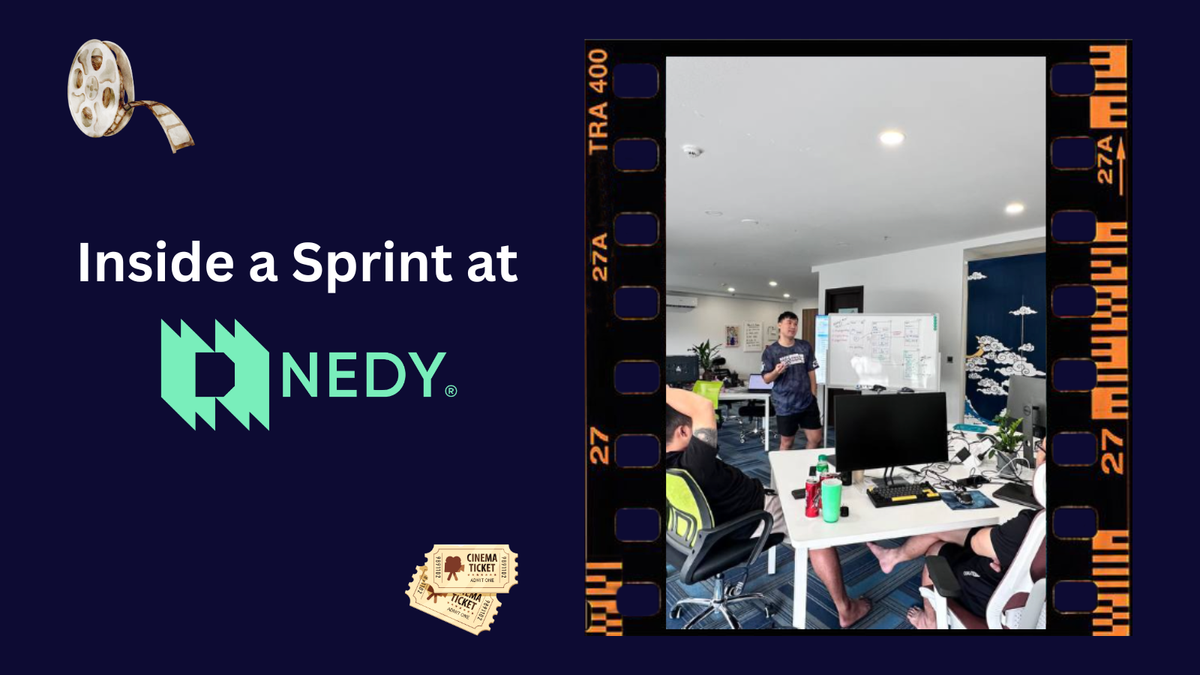A Sprint at Nedy: Inside Our Two-Week Development Cycle

[Vietnamse Summary Below]
At Nedy, speed and adaptability are essential. To keep pace with shifting priorities and user needs, we follow a two-week Scrum sprint cycle—a structured rhythm that helps our teams stay focused, deliver consistently, and continuously improve.
Here’s a look at what a typical sprint looks like at Nedy, from planning to retrospective:
Day 1: Sprint Planning
Every sprint begins with a Sprint Planning session, usually on Friday afternoon of the week before. The Product Owner comes prepared with a prioritized backlog of tasks aligned with business goals. Together with the Development Team, we discuss:
- What features or fixes are highest priority
- The acceptance criteria for each task
- How much work can realistically be committed to in the two-week window
The team breaks down user stories into smaller tasks and estimates effort using story points. By the end of the meeting, we have a clearly defined Sprint Goal and a Sprint Backlog—the list of tasks we aim to complete.
Daily: Stand-Up Meetings
Every day starts with a 15-minute stand-up at 09:45 AM. Each team member answers three questions:
- What did I do yesterday?
- What will I do today?
- Are there any blockers?
These short meetings keep everyone aligned, surface issues early, and build team accountability. The Scrum Master/ Project Manager takes note of any blockers and works to remove them quickly.
Mid-Sprint: QA & Iteration
Around Day 6 or 7, we start handing off completed features to QA. At Nedy, we follow a test-as-you-go mindset—developers write unit tests, and QA handles functional testing.
Bugs or UX issues are logged in Jira and either resolved within the sprint or, if critical, moved to the next sprint with proper documentation.
Designers also jump in during this phase to provide quick feedback or minor UI adjustments.
Day 14: Sprint Review & Demo
On the final Friday of the sprint, we host a Sprint Review. The team walks through completed features in a live demo, with the Product Owner and stakeholders present.
This is not just a checklist session—it’s a chance to:
- Show progress
- Collect feedback
- Discuss how the features impact our users
The review ends with a decision: do the delivered items meet the Definition of Done? If not, they’re rolled into the next sprint or redefined.
Day 14 (Also): Sprint Retrospective
After the review, we hold a Retrospective—a safe space for reflection. The team answers:
- What went well?
- What didn’t go well?
- What should we do differently next sprint?
At Nedy, we keep retros action-focused. One or two clear improvements are chosen and assigned to ensure follow-through.
Why It Works for Us
Our two-week sprint cycle provides just the right balance: enough time to ship meaningful features, but short enough to pivot quickly. It helps Nedy stay agile without sacrificing quality.
By sticking to this rhythm, we ensure that everyone—from developers to designers to leadership—is in sync and moving toward a shared product vision.
[Vietnamese Summary]
Tại Nedy, chúng tôi vận hành theo chu kỳ Scrum hai tuần để đảm bảo tốc độ, tính linh hoạt và khả năng phản ứng nhanh với nhu cầu thay đổi. Một sprint thường bắt đầu bằng buổi Sprint Planning vào chiều thứ Sáu, nơi Product Owner cùng đội ngũ phát triển chọn các đầu việc ưu tiên và xác định rõ Sprint Goal cùng Sprint Backlog.
Mỗi ngày, nhóm đều tham gia daily stand-up lúc 9g45 sáng để cập nhật tiến độ, chia sẻ kế hoạch và báo cáo các vướng mắc cần hỗ trợ từ Scrum Master hoặc Project Manager.
Đến giữa sprint, các tính năng đã hoàn thiện được chuyển sang QA để kiểm thử. Lỗi hoặc vấn đề UX sẽ được ghi lại trên Jira và xử lý ngay nếu cần thiết. Đội thiết kế cũng hỗ trợ kiểm tra và chỉnh sửa giao diện nếu cần.
Ngày cuối sprint (thứ Sáu tuần sau) là lúc diễn ra Sprint Review (demo sản phẩm) và Retrospective (đánh giá sprint). Đây là cơ hội để chia sẻ kết quả, nhận phản hồi và cải tiến quy trình làm việc.
Chu kỳ hai tuần này giúp đội ngũ Nedy duy trì sự đồng bộ, liên tục cải tiến và luôn hướng đến mục tiêu chung của sản phẩm.





